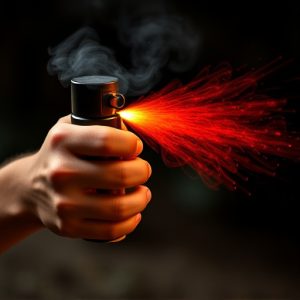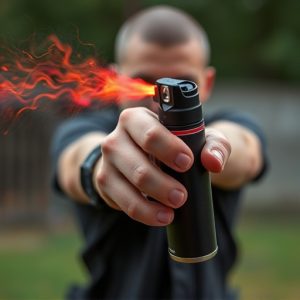Mastering Pepper Spray Safety: Protocols, Care, and Prevention
Understanding the composition of pepper spray is key for safe handling and effective treatment. Caps…….
Understanding the composition of pepper spray is key for safe handling and effective treatment. Capsaicin, derived from chili peppers, causes temporary blindness, coughing, and breathing difficulties upon contact. Immediate actions include removing contaminated clothing, rinsing eyes with water for 15+ minutes, and seeking medical attention for severe reactions. Law enforcement officers require specialized training to deploy pepper spray responsibly and treat exposure effectively. Proper first aid for victims involves easing breathing, flushing eyes, and neutralizing skin contact. Regular equipment maintenance and comprehensive training are vital to prevent misuse and ensure safety in cases of pepper spray exposure.
“Pepper spray, a powerful law enforcement tool, has revolutionized crowd control tactics. This article delves into the intricacies of this weapon, exploring its composition, effects, and responsible usage by police forces worldwide. We dissect the protocols, training, and safety measures surrounding its deployment, emphasizing the importance of immediate and long-term exposure treatment.
Learn about prevention strategies and responsible handling to effectively manage pepper spray incidents, including practical tips on how to treat pepper spray exposure.”
- Understanding Pepper Spray: Composition and Effects
- Law Enforcement Usage: Protocols and Training
- Treating Exposure: Immediate and Long-Term Care
- Safety Measures: Prevention and Responsible Handling
Understanding Pepper Spray: Composition and Effects
Pepper spray, a powerful law enforcement tool, is a chemical agent designed to incapacitate and disorient suspects temporarily. Its active ingredient is capsaicin, derived from chili peppers, which irritates the eyes, nose, and respiratory system when in contact. This irritation leads to temporary blindness, coughing, and difficulty breathing, allowing officers to control and subdue individuals safely.
When dealing with pepper spray exposure, understanding its composition is key to effective treatment. If exposed, immediate steps should be taken, such as removing contaminated clothing and rinsing eyes thoroughly with water for at least 15 minutes. The primary goal is to dilute the capsaicin and prevent further contact with the skin or eyes. Seeking medical attention is crucial if symptoms persist or severe reactions occur, ensuring individuals receive appropriate care based on the extent of exposure.
Law Enforcement Usage: Protocols and Training
Law enforcement officers often carry pepper spray as a non-lethal tool for crowd control and self-defense. When deployed, pepper spray irritates the eyes, nose, and throat, temporarily disabling an individual. However, it’s crucial to understand that its usage is strictly regulated and requires specialized training.
Officers are trained in protocols that dictate when and how to use pepper spray. This includes learning how to assess a situation, ensure public safety, and minimize harm to subjects. After deployment, understanding how to treat pepper spray exposure is vital. This involves providing immediate medical attention, including removing contaminated clothing, irrigating the eyes and respiratory tract, and monitoring for potential complications. Proper training equips officers with the skills to handle these situations effectively while ensuring their safety and the public’s well-being.
Treating Exposure: Immediate and Long-Term Care
Pepper spray exposure requires immediate and thorough care, especially for individuals who have been directly targeted or experienced prolonged contact. The first step is to move the affected person to a safe, well-ventilated area away from the source of the spray. This reduces the risk of further inhalation and allows for easier cleaning. Inhaling pepper spray can cause immediate discomfort, including coughing, difficulty breathing, watering eyes, and runny noses. It’s crucial to seek medical attention if symptoms persist or worsen, as these could indicate more severe respiratory issues.
Long-term care involves addressing potential complications from the exposure. Skin irritation, burns, and eye damage are common side effects that may not be immediately apparent. Thorough washing with soap and water can help remove any residual spray from the skin, while eye flushing with clean water for at least 15 minutes is recommended to prevent or reduce eye irritation. In cases of severe eye pain, vision changes, or prolonged redness, medical evaluation is essential. How to treat pepper spray exposure effectively involves a combination of quick response and adequate follow-up care to ensure the best possible outcome.
Safety Measures: Prevention and Responsible Handling
Pepper spray, while a valuable tool for law enforcement, can cause significant discomfort and potential health risks if not handled responsibly. Understanding how to prevent exposure and properly manage its effects is crucial. Officers must receive comprehensive training on safe handling procedures, including storage guidelines, proper application techniques, and de-escalation strategies. Regular maintenance of equipment and ensuring the integrity of cartridges are essential steps in preventing accidental deployment or misuse.
In the event of exposure, knowing how to treat pepper spray symptoms is vital. Victims may experience respiratory distress, pain, and temporary blindness. First responders and bystanders should be equipped with basic first aid skills tailored for pepper spray exposure, focusing on easing breathing, flushing eyes, and neutralizing skin contact. Quick thinking and appropriate action during these critical moments can significantly mitigate the impact of pepper spray and ensure the safety of all involved.
Pepper spray, while a valuable tool for law enforcement, requires careful handling and responsible usage. Understanding its composition, effects, and proper protocols is essential. Knowing how to treat pepper spray exposure, both immediate and long-term, is crucial for ensuring the safety of individuals affected. By adhering to safety measures and preventive practices, law enforcement agencies can minimize risks associated with this weapon. Effective training and adherence to guidelines are key to responsible handling, ultimately enhancing public safety during interactions involving pepper spray.


